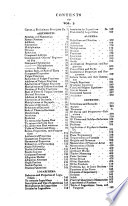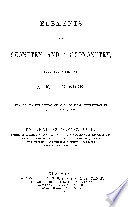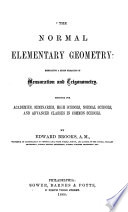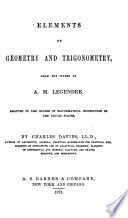 | Charles Hutton - Mathematics - 1831 - 660 pages
...a series of equal ratios, I = у = v — fi ; we nave 6+Ю4-14+30 14 30 3+5+7+15- У Ï5THEOREM vi. In any series of equal ratios, the sum of the antecedents is to that of the consequents, as any one antecedent is to its consequent. THEOREM vu. If two proportions... | |
 | William Smyth - Algebra - 1851 - 272 pages
...the same principle, we have and thus in order, whatever the number of equal ratioS. Therefore, in a series of equal ratios, the sum of the antecedents is to the sum of the consequents, as any one antecedent is to its consequent. Let us take next the two proportions If we now multiply these equations... | |
 | Charles William Hackley - Trigonometry - 1851 - 536 pages
...A4 : A4' : : be : be' : : cd : cd', &c. PLANE SAILING. therefore, since by the theory of proportion the sum of the antecedents is to the sum of the consequents as any one antecedent is to its consequent, A* : A6' : : A4 + be + cd + &c., : A4' + be' + cd' + >fec. But AJ... | |
 | Thomas Sherwin - Algebra - 1855 - 262 pages
...the sum of the antecedents, and the second is the sum of the consequents, of the given ratios. Hence, is to the sum of the consequents, as any one of the antecedents is to its consequent. (xiv). Suppose we have the two proportions a : 6 = c : ¿, and e:f=g:h. These are the same as — =... | |
 | Samuel Alsop - Algebra - 1856 - 152 pages
...§1O«5. If any number of like magnitudes be proportionals, one antecedent will be to its consequent as the sum of the antecedents is to the sum of the consequents. Let a : Ъ : : с : d : : e :f, then a:b::a-\-c-{-e:b-{-d -)-/• For since a : b : : с : d, and a... | |
 | Thomas Sherwin - 1862 - 252 pages
...the sum of the antecedents, and the second is the sum of the consequents, of the given ratios. Hence, is to the sum of the consequents, as any one of the antecedents is to its consequent. (xiv). Suppose we have the two proportions a : b = c : d, and e:f=g:h. These are the same as ac , _... | |
 | Olinthus Gregory - 1863 - 482 pages
...series of equal ratios represented by f we shall have - « - * - V - ««• T • - Tj Therefore, in a series of equal ratios, the sum of the antecedents is to the sum of the consequents, as any one antecedent is to its consequent. If there be two proportions, as 30 : 1 5 : : 6 : 3, and 2 : 3 : :... | |
 | Adrien Marie Legendre - Geometry - 1863 - 464 pages
...shall have, A±PA : B±*-B :: C ±2,0 : 2>±^D; PEOPOSITION XI. THEOEEM. In any continued proportion, the sum of the antecedents is to the sum of the consequents, as any antecedent to its corresponding consequent. From the definition of a continued proportion (D. 3), A... | |
 | Edward Brooks - Geometry - 1868 - 284 pages
...THEOREM XII. If any number of quantities are in proportion, any antecedent will be to its consequent as the sum of the antecedents is to the sum of the consequents. Let A:B:: C: D:\E\F, etc. A : B : : E : F; we have A x .D = S X C, and AXF= B X E; adding to these,... | |
 | Charles Davies - Geometry - 1872 - 464 pages
...have, DD* A±*-A : *± P -B :: C±$C : D ± *D; PBOPOSITION XI. THEOREM. In any continued proportion, the sum of the antecedents is to the sum of the consequents, as any antecedent to its corresponding consequent. From the definition of a continued proportion (D. 3), A.... | |
| |